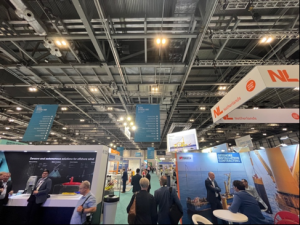Complexities of the Offshore Wind Supply Chain
July 18, 2023
Our program had the opportunity to attend the Global Offshore Wind conference in London. Today marked the first day of the two-day program.
This year’s conference centered around themes of offshore wind resiliency, grid systems, and supply chains. One of the first speaker panels I attended highlighted all three of these themes by discussing the process of securing the United Kingdom’s energy future and the role offshore wind will play to reach the UK’s net-zero targets by 2050. One of the biggest challenges facing the offshore wind industry is the current size of its supply chain. The supply chain is currently too small and nascent to efficiently move offshore wind projects through the development pipeline fast enough to reach the UK’s net-zero targets.
Through this panel and other discussions with industry professionals, there appear to be two key strategies to help grow the offshore wind supply chain. The first strategy is building bridges across industries to bring current workers employed in the oil and gas sector to the offshore wind and renewables sector. This transition also includes encouraging college graduates to move towards the offshore wind industry rather than the oil, gas, and fossil fuel industry. The second strategy is to standardize offshore wind products and projects to help bolster supply chain growth. The offshore wind industry experiencing rapid and high levels of technological innovation. However, this innovation puts pressure on supply chains as they must consistently adapt and industrialize new processes, which slows down offshore wind project development. Standardization of offshore wind projects will help bolster supply chains and make them more resilient because, as noted in the panel, the technology of offshore wind is already advanced enough to reach the net-zero targets.
After this panel, a question that resonated with me throughout the conference is: How should the offshore wind industry navigate technological innovation, which is vital in any industry, while standardizing processes to grow supply chains and propel project efficiency to ensure net-zero targets are reached?
I discussed the challenge of offshore wind standardization with Arnold van der Line, Sales and Concept Engineer at Huisman. As a company, Huisman develops construction equipment to build energy systems. For example, Huisman develops crane systems on boats to build offshore wind turbines. However, Line noted that for almost every offshore wind project, Huisman must create a new crane system to assemble the turbines. Each project is so different from prior projects due to technological innovations that their current cranes are either too small or are not capable of building new turbines without damaging them. The process of developing new cranes makes finding investors for new projects difficult as there is high risk associated with ensuring a return on investment.
Stepping away from my conversation with Line demonstrated the complexity of the offshore wind supply chain and the challenges associated with standardizing it. However, while challenging, there is extensive opportunity to create impactful change within this industry.
Pivoting from supply chains, one of the most impactful conversations I had at the conference was with Andrew Harwell, Senior Sustainability Specialist at Vestas. He discussed Vestas’s plans on becoming net-zero without relying on carbon offsets. While a challenging process, it was fascinating to learn the steps Vestas is taking to reduce its emissions. A key area of emissions the company is focusing on reducing is in its operations and management sector. Vestas’s initiatives of decarbonization should act as a model for other successful companies to reduce their carbon footprint in efforts to combat climate change.
The Global Offshore Wind Conference provided me with insightful, unique, and innovative perspectives on this growing sector and makes me eager to bring these strategies and approaches to renewable energy systems back to the United States.
About the Author
This article was written by Levi Mellin, Environmental Studies, Class of 2025

